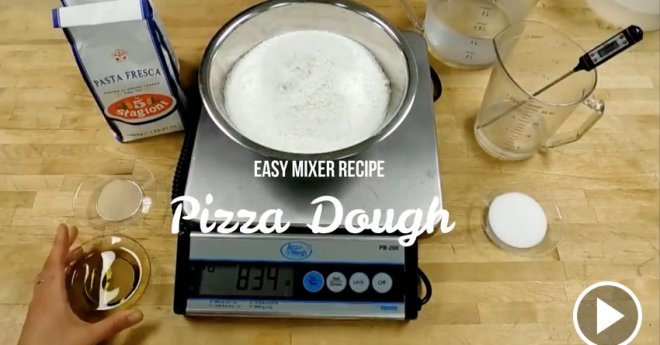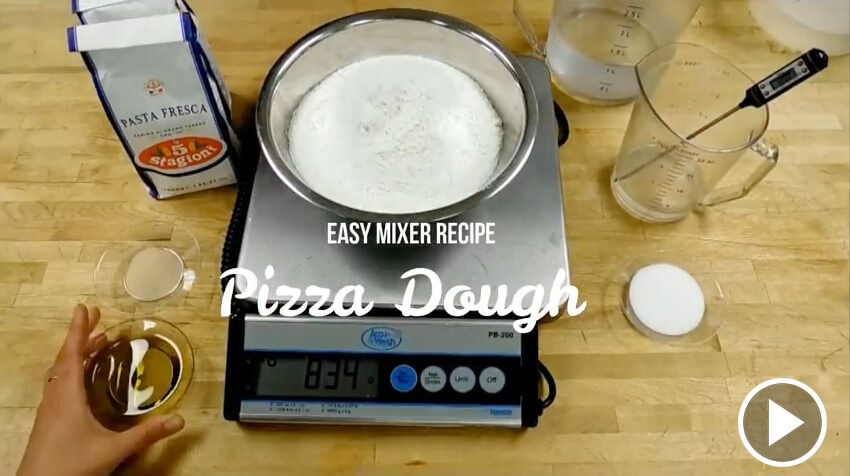
EASY MIXER PIZZA DOUGH
Jul 12, 2017Posted by David BergerPrintAuthentic pizza dough recipe for brick oven pizza
Chef’s note: This recipe is for a slow refrigerated dough with a high protein level. A minimum of 24 hours, up to 72-96 hours fermentation is required. It uses less yeast than many other recipes, but with the mixing and long fermentation, yields a delicious result!
Yields: Dozen 250 gram dough balls – about the size of a personal pizza
* This dough recipe can be made in any capacity you choose. Just multiply the values for the batch size you want.
Ingredients
- 2.5 g dry yeast
- 100 mL warm water 97° – 101°F (Optional: sugar, honey, molasses, or malt can be added to speed up the fermentation.)
- 1,000 g flour
- 850 g flour
- 1 liter cold water
- 50 g salt* (see note below)
- 30 g olive oil (optional)
Instructions
- Mix 2.5 grams of Dry Yeast in 100 ML of warm water (97° – 101°F). Allow to rest for 5 -15 minutes to activate, until it begins to foam.
- Mix 1,000 grams of flour and the activated yeast water. Mix for 2 – 3 minutes.
- Add 1 liter cold water. Mix for 3 – 5 minutes, until you achieve pancake batter consistency.
- Add 50 grams of salt and the additional 850 grams of flour. Mix 5-10 minutes until dough begins to pull away from bowl.
- Add an optional 30 grams of olive oil to finish. Mix until well incorporated. The dough is done when it develops soft pleating (waves) and a bun like appearance.
- Rest Cover dough in a damp towel or clear wrap and allow to rest for 10 – 15 minutes.
- Measure Using a scale, measure out 250 grams of dough. Note: Only portion out what you can round. Keep the rest of the dough covered to prevent a skin from developing.
- Round Push air out by stretching the top of the dough and tucking it toward the bottom. Round dough balls on a lightly floured surface, compressing and spinning the dough until it is rounded on top and smooth on the bottom. (*See video for an example of this technique)
- Rest dough in refrigerator overnight (up to 3 days) in a dough box or covered container with room between the balls to allow them to expand.
- Remove dough from the refrigerator at least a 1/2 hour before using it, allowing it to come up to room temperature for best results.
- Roll out on a lightly floured surface (or dimple and hand stretch the dough), top with your favorite ingredients, and bake!
Tips
- When preparing (activating) the yeast, look for a frothy, cappuccino appearance.
- Use a spiral mixer, like the PEP-5kg Spiral Mixer. It can better handle a tougher, high-gluten dough used in pizza and bread.
- Add salt near the end of the dough making process; adding it too early can kill the yeast.
- Another note from the chef regarding salt — “50 g provides a good balance, based on the salinity of the “Galbani” Brand cheese that we use. Add or subtract as required to fit your palate and toppings.” (Variation: Some community member prefer using closer to 25 grams of salt instead for a different flavor profile.)
- Make dough in advance and “age” it for a couple of days. The cold fermentation process improves dough’s taste, texture, and cell structure.
Learn more about Pizza Equipment Pros at www.pizzaequipmentpros.com





